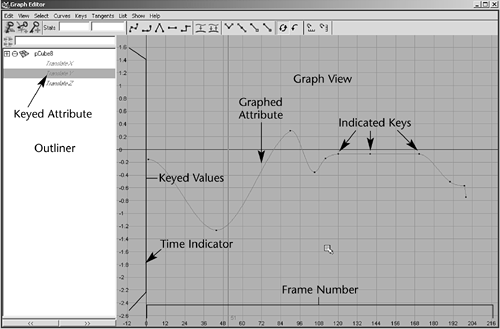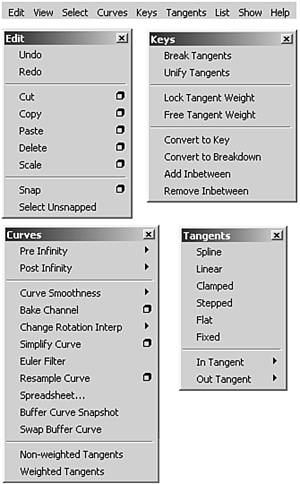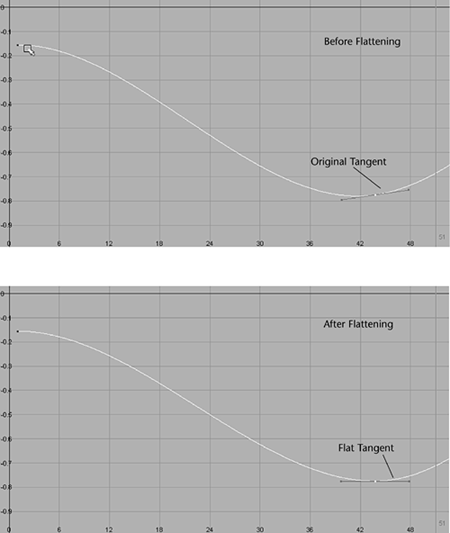Using the Graph Editor
| The Graph Editor, shown in Figure 11.5, is a helpful tool for tweaking values for keys you have set. It gives you a visual representation a curved line of the attributes that are animated. The animation time goes from left to right, and any keyed variable appears as a line that ramps up or down to indicate its value over time. It can help you visualize how things are changing and how fast. You can pan and zoom this panel like any other. Figure 11.5. You can easily work with keys in the Graph Editor.
You can use the Graph Editor as a free-floating window or set it up as one of the viewports. To use it as a free-floating window, simply open it from the Hotbox (Window | Animation Editors | Graph Editor). To set it up in a viewport that displays the Perspective view and the Outliner, click Hotbox | Panels | Saved Layouts | Persp/Outliner/Graph. As you go through the next tutorial, try both layouts to see which one works better for you. The following list takes you on a brief tour through the Graph Editor's components:
tip The Dope Sheet is another animation editor in Maya that is similar to the Graph Editor. Instead of displaying curves, the Dope Sheet displays key times as colored rectangles and lets you edit event timing in blocks of keyframes and synchronize motion to a sound file. Tutorial: Tweaking Keys with the Graph Editor This tutorial gives you a chance to work with the Graph Editor. If you like, you can load the previous tutorial's scene file (see the file next to the DVD icon) to make sure everything's set up correctly.
note You might have expected to see a more dramatic change in the animation curve after adjusting the tangent. The change in the animation curve's line is subtle in the Graph Editor, but the effects on the animation are noticeable. You can set several types of tangents for your keys. Feel free to experiment with them to see how they work. For example, you can click the Break Tangents button so that you can grab each side of the handle and move it independently. tip If you want to insert more keys to try smoothing the animation more, simply click the Insert Keys button on the Graph Editor's toolbar and MMB-click in the Graph view. |
EAN: 2147483647
Pages: 198
- ERP System Acquisition: A Process Model and Results From an Austrian Survey
- The Second Wave ERP Market: An Australian Viewpoint
- Enterprise Application Integration: New Solutions for a Solved Problem or a Challenging Research Field?
- The Effects of an Enterprise Resource Planning System (ERP) Implementation on Job Characteristics – A Study using the Hackman and Oldham Job Characteristics Model
- Intrinsic and Contextual Data Quality: The Effect of Media and Personal Involvement
- Key #3: Work Together for Maximum Gain
- Key #4: Base Decisions on Data and Facts
- Making Improvements That Last: An Illustrated Guide to DMAIC and the Lean Six Sigma Toolkit
- The Experience of Making Improvements: What Its Like to Work on Lean Six Sigma Projects
- Six Things Managers Must Do: How to Support Lean Six Sigma



